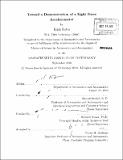| dc.contributor.advisor | Shaoul Ezekiel and Richard Stoner. | en_US |
| dc.contributor.author | Kotru, Krish | en_US |
| dc.contributor.other | Massachusetts Institute of Technology. Dept. of Aeronautics and Astronautics. | en_US |
| dc.date.accessioned | 2011-04-25T16:07:04Z | |
| dc.date.available | 2011-04-25T16:07:04Z | |
| dc.date.copyright | 2010 | en_US |
| dc.date.issued | 2010 | en_US |
| dc.identifier.uri | http://hdl.handle.net/1721.1/62486 | |
| dc.description | Thesis (S.M.)--Massachusetts Institute of Technology, Dept. of Aeronautics and Astronautics, 2010. | en_US |
| dc.description | Cataloged from PDF version of thesis. | en_US |
| dc.description | Includes bibliographical references (p. 79-81). | en_US |
| dc.description.abstract | The Light Force Accelerometer (LFA) is an optical inertial sensor in which radiation pressure from two counter-propagating laser beams optically confines a glass microsphere. Inertial acceleration of the device results in microsphere displacement along the sensitive axis, which is subsequently nulled by optical forces to provide an acceleration measurement. A simple calculation that takes into account fundamental noise processes in the LFA (i.e., shot noise and RIN in the laser beams) places the sensitivity limit of this accelerometer at < 100 ng. By incorporating widely available, inexpensive optical components into a simple design, a high-precision LFA could provide an appealing alternative to other sensors of comparable performance. Previous work on the LFA revealed instabilities in proof mass position detection caused by the asphericity of microspheres. In this thesis, an alternative method for position detection which was less sensitive to shape-irregularities in microspheres was investigated. Results indicated that resolution of microsphere motion was enhanced significantly when the new detection method was implemented. This improvement. however, did not eliminate the position instabilities observed previously. Capabilities for optical trapping with two counter-propagating beams in air were also developed in this work. Trapping with feedback position control in air was demonstrated for the first time, but long-term trapping in vacuum was prohibitively difficult due to destabilizing mechanical vibrations. For a microsphere in atmospheric pressure, the estimated bias stability was 318 jig after 300 seconds of averaging, and the approximate short-term sensitivity was 500 pg/v/ Hz. Stabilization of mechanical vibrations and precise calibration of power measurements to acceleration will allow this two-beam trap to probe the performance limits of the LFA. | en_US |
| dc.description.statementofresponsibility | by Krish Kotru. | en_US |
| dc.format.extent | 81 p. | en_US |
| dc.language.iso | eng | en_US |
| dc.publisher | Massachusetts Institute of Technology | en_US |
| dc.rights | M.I.T. theses are protected by
copyright. They may be viewed from this source for any purpose, but
reproduction or distribution in any format is prohibited without written
permission. See provided URL for inquiries about permission. | en_US |
| dc.rights.uri | http://dspace.mit.edu/handle/1721.1/7582 | en_US |
| dc.subject | Aeronautics and Astronautics. | en_US |
| dc.title | Toward a demonstration of a Light Force Accelerometer | en_US |
| dc.title.alternative | Toward a demonstration of a LFA | en_US |
| dc.type | Thesis | en_US |
| dc.description.degree | S.M. | en_US |
| dc.contributor.department | Massachusetts Institute of Technology. Department of Aeronautics and Astronautics | |
| dc.identifier.oclc | 712067533 | en_US |
